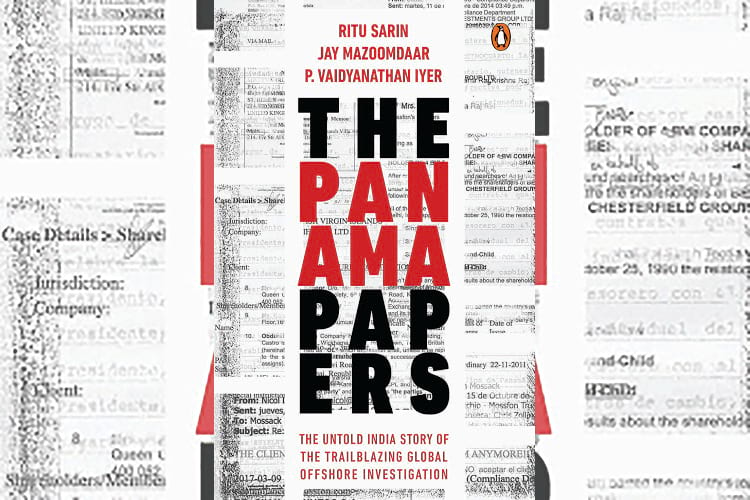Newly Released Book The Panama Papers Unveil the Indian Side of the Biggest Global Corruption Scandal
Share
 Panama Papers was the culmination of a long and international journalistic investigation. In this rare expose, 2.6 terabytes of data of tax evasion by the rich and their illegal accounts to cover up suspicious business dealings were leaked into public forums. By implicating the rich and the famous in India, the disclosures sent shock waves rippling throughout the length and breadth of the country. The reactions of the Indian government and public, plus the actions taken are explored in the book The Panama Papers, by the three senior journalists—Ritu Sarin, Jay Mazoomdaar, and P. Vaidyanathan Iyer—who were at the forefront of bringing this to the eyes of the Indian Public.
Panama Papers was the culmination of a long and international journalistic investigation. In this rare expose, 2.6 terabytes of data of tax evasion by the rich and their illegal accounts to cover up suspicious business dealings were leaked into public forums. By implicating the rich and the famous in India, the disclosures sent shock waves rippling throughout the length and breadth of the country. The reactions of the Indian government and public, plus the actions taken are explored in the book The Panama Papers, by the three senior journalists—Ritu Sarin, Jay Mazoomdaar, and P. Vaidyanathan Iyer—who were at the forefront of bringing this to the eyes of the Indian Public.
The Reaction of the Modi government
The issues of reining in corruption and curtailing black money had stumped previous Indian governments, but there was an expectation that things would be different when Narendra Modi stepped in as Prime Minister.
“On its first day in office and at the very first cabinet meeting on 27 May 2014, the government had announced that it would constitute a Special Investigating Team (SIT) ‘to implement the decision of the Honorable Supreme Court on large amounts of money stashed abroad by evading taxes or generated through unlawful activities’.”
After the Panama Papers were released worldwide on 5 April 2015, the Modi government swung into action to set up an exclusive probe team to trace undisclosed offshore investments. As per a statement issued by the finance ministry, the Multi Agency (MAG) was to include:
“…officers from Investigative Unit of CBDT (Central Board of Direct Taxes), FIU (Financial Intelligence Unit) and FT & TR (Foreign Tax and Tax Research) division and representative of RBI (Reserve Bank of India).”
Meanwhile, the three Indian Express journalists began giving TV interviews—including one to Ravish Kumar—about their nine-month-long investigation. They also conducted an hour-long AMA on Reddit, and, a month later, participated in an off-the-record two-hour event to acquaint 200 of the newspaper’s readers about the Panama Papers. Additionally, separately, they gave talks at student gatherings, plenary sessions, and conferences in India and abroad.
Public reaction was mixed. Many people were outraged and angrily demanded that action be taken against the 500 Indian citizens that the Panama Papers had revealed to have illegal offshore investments. Others received the news with jaded scepticism and said that this government, like the ones before it, would do precisely nothing.
Tax Sleuths Take Action
The book also covers how the tax authorities in India began to investigate and take action against many of the people named in the Panama Papers. They also sent out feelers for international cooperation. On 13 April 2016, director level officer from India’s CBDT attended an OECD (Organization for Economic Cooperation and Development) meeting in Paris.
“At the Paris meet, a coordination plan was formulated under the aegis of the Joint International Tax Shelter Information & Collaboration Network (JITSIC), which itself is tasked with responding to global tax-compliance issues and ensuring fast and effective information exchange between tax administrations.”
The tax sleuths in India sent the named Indians detailed questionnaires about their offshore investments, and then began raiding their residences and offices. They also sent official notices to NRIs named in the investigation and requested tax authorities for information in other countries with whom India had tax treaties. They then filed prosecutions in Indian courts under the Income Tax Act and the Black Money Act provisions.
“…RTI reply received from the Ministry of Finance by Ritu in June 2019 revealed that the ‘undisclosed investments’ traced in the Panama Papers case had gone up to a whopping Rs 1564 crore.”
Nevertheless, many people were left disappointed by the secrecy in the search operations and prosecutions. The income tax department, the Enforcement Directorate (ED), and the MAG did not make any of the names public.
“This, understandably, resulted in questions being asked as to whether the ‘big fish’ named in the Panama Papers had been let off the hook and only the ‘small fry’ were being dragged to court.”
The government prosecuted little-known traders and businessmen in Mumbai, Sikkim, Ahmedabad, West Bengal, and Bengaluru, and that led the Congress and the AAP to accuse the Modi government of being selective in the official probe. They wanted the probe to be monitored by the Supreme Court of India. A lawyer also filed a public interest litigation plea towards this end, but it ended up being dismissed.
“With that, the Panama Papers investigation would remain an internal probe with the identities of those facing the heat and the details of their undisclosed assets known to only a select few.”
However, as the book goes on to detail, the Panama Papers revelations did succeed in showing how the rich and powerful can bypass tax laws or find legal loopholes to avoid taxation. It also states that, ultimately, business transparency will be difficult to achieve without political transparency.













